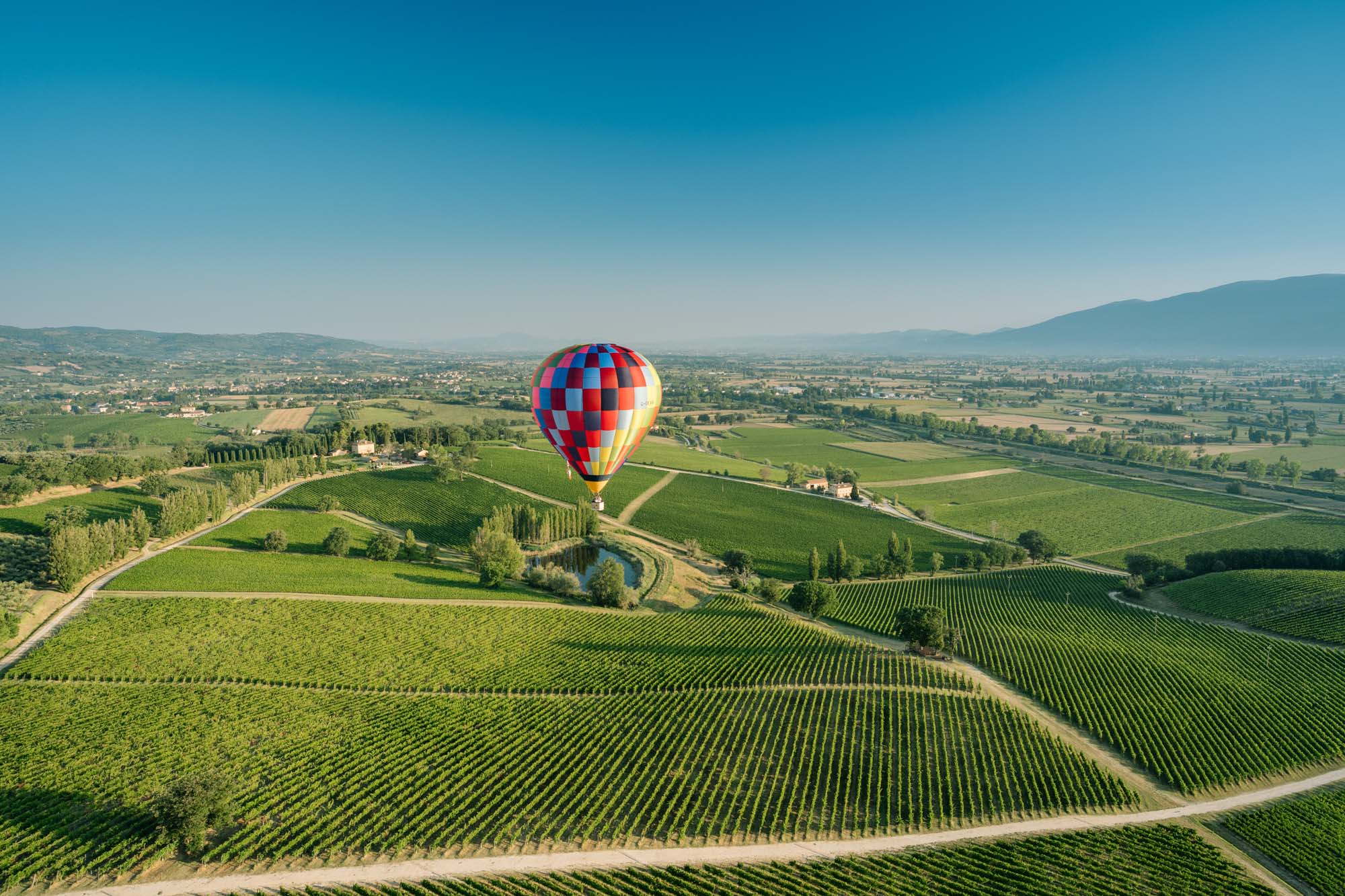
The typical growing area includes the municipality of Montefalco, part of the territory of the municipalities of Bevagna, Gualdo Cattaneo, Castel Ritaldi and Giano dell'Umbria, all in the province of Perugia. This vine can be used for the production of Sagrantino di Montefalco DOCG and Montefalco Rosso DOC.
Ampelographic characteristics of the vine
Sprout apex fan-shaped, whitish green, with carminate edges. Adult leaf medium, trilobed sometimes quinquelobed; U-shaped petiolar sinus; upper page vesicular or bullous; lower page has downy-type tomentosity. Nerves bristly, medium to broadly toothed, narrow base, margins slightly convex. Bunch medium-small, cylindrical-conical, winged, sometimes sparse due to dripping. Berry small with medium to very pruinose skin, black in colour, medium thick, firm.
Phenology
Sprouting: medium
Flowering: precocious : precocious
Flooding: media
Maturationmedium-late
Agronomic skills
Vegetation growth: semi-erect
Physiological aspects: Slight dripping, sensitive to magnesium deficiency
Vigour Low
Potential bud fertility : Media
Basal bud fertility : Media
Environmental and cultivation requirements
In its cultivation area it expresses itself well in all soils, even in deep and fresh ones, obviously producing wines with different characteristics but nevertheless of excellent quality. In clay-limestone soils it reaches optimal levels of physiological ripeness, optimising the content of polyphenolic substances. It fears magnesium deficiencies or excesses of potassium. Prefers compact forms of cultivation with high or very high density (spurred cordon and guyot). On traditional forms of cultivation it produces excessively and delays ripening. Can give disaffinity phenomena if grafted onto certain 420A clones.
Sensitivity to disease and adversity
High resistance to winter and spring cold, medium tolerance to powdery mildew and rot (acid rot and botrytis), poor to downy mildew, particularly on leaves.
Oenological skills
Chemical characteristics of grapes
Sugar content °Babo : 20-24
pH : 3.2-3.4
Total acidity g/L : 5.0-7.0
Total anthocyanins mg/kg: 1000-1400
Total polyphenols mg/kg: 4500-5000
Total polyphenols perc.skins/grapes: 70/30
Oenological use and wine characteristics
In purity it produces Sagrantino di Montefalco DOCG, blended with other vines it gives rise to Montefalco Rosso DOC. The wine produced is a very intense ruby red colour with violet reflections; the aroma is very persistent on the nose with typical hints of blackberry, plum and leather that perfectly combine with the vanilla provided by the wood. The taste is powerful, soft and velvety. Sagrantino is a wine for long ageing, at least 10-15 years. It can also be used as a dessert wine, after drying the grapes.
Copiright 2004
General Catalogue 2003 of Vitis Rauscedo Soc. Coop. a r.l
Edited by: Prof Leonardo Valenti, Dr Stefano Farinelli,
Dr Angelo Divittini, Dr Carletti Filippo.

You cannot talk about Umbria and Montefalco today without mentioning Sagrantino. A very old vine that produces red grapes with exceptional characteristics for both long ageing wines and passito wines.
Its origins even seem to date back to Roman times. Pliny the Elder in his Naturalis Historia hints at the vine itriola o IrciolaUmbria of Bevagna' and the Picenum; in 1953 the archaeologist Carlo Pietrangeli hypothesised the juxtaposition of theItriola with the Sagrantina grape, bearing in mind that the territory of Montefalco was part of the municipality of Bevagna.
According to some, Sagrantino came to Umbriaparticularly in the Montefalco area, thanks to the Franciscan friars from Asia Minor. According to othersinstead, would have been spread in the area in medieval times by Byzantine monks arriving from Greece.
It is however during the Middle AgesThis was due to the growing importance of wine in religious communities and the increasingly widespread practice of winemaking in monasteries and the countryside, thanks to the commitment of the friars and monks, which the role and importance of the grape variety is increasingly assertedso much so that the municipal accounting records testify to Montefalco wine being sent as gifts to cardinals and pontiffs.
Part of his name 'sacred' could, therefore, derive precisely from these religious roots, from the fact that it was a mass wine or, more simply, a sacristy or sacristy wine.
In the Middle Ages, vineyards were one of the cornerstones around which people and communities organised their lives. This is demonstrated by the church of St Bartholomewone of the oldest parishes in Montefalco, first documented in 1219, which has a single lancet window in the outer apse wall decorated with vine shoots and clusters and other typical medieval motifs.
And it proves it statutory legislation, which devotes special attention to vines and grapes. In the historical archives of Montefalco, there are numerous documents that testify to the constant care that '[...] the vine-dressers reserved for the field planted with vines'.
In 1451the famous Florentine painter Benozzo Gozzolicalled by the Franciscans to fresco the apse of their church, now the Civic Museum of Montefalco, perhaps alludes precisely to Sagrantino, painting the bottle of red wine on the table set by Cavaliere da Celano as part of the pictorial cycle of the 'Story of the Life of St. Francis.
Medium-sweet grapes and robust berries that are unlikely to rot are the innate qualities of Sagrantino. This vine has a fairly low vigour and prefers medium-textured, siliceous-clayey soils with a southern exposure, and generally gives rather irregular yields.While it is currently vinified mainly for the production of dry wines, it seems that in ancient times tradition preferred a sweet type, obtained by drying the grapes on wooden racks. Whether dry or raisin wine, according to the Disciplinare, it must be aged for at least thirty-six months, of which, for the dry, at least twelve in wooden barrels.
Sagrantino specifications are among the oldestas early as the 14th century, documents testify to the existence of rules to protect and regulate its cultivation, harvest and production. In 1540, there are records in Montefalco of a municipal ordinance that established the date of the grape harvest.
During the Renaissance period, the wine of Montefalco was known and appreciatedso much so that in the 1565 Cipriano Piccolpasso, superintendent of the fortress of Perugia, in his report on the Papal State for the Pope, specifically dedicated to the cities and territories subject to the government of Perugia, writes: "[...] Montefalco, located on a hill with a beautiful view, is adorned with beautiful and good vineyards, cultivated land and great fruit, makes fine wines [...]". We can safely say that Sagrantino is at least more than four hundred years old.
One of the oldest testimonies of the Sagrantino grapekept in a notebook of the Assisian notary Giovan Maria Nuti, dates back to 1598 and is currently kept in the Notary Archives of Assisi. The notary reports on the custom, widespread in Foligno, of mixing Sagrantino with musts to give them aroma and flavour.
The Itriola grape is also mentioned in the De naturali vinorum historia, de vinis Italiae and de convivis antiquoruma fundamental work in Italian Renaissance wine history, published in 1595 by Andrea Bacci, who defines it as particularly suitable for the production of Moscatelli. The Marche doctor and naturalist also recalls the assiduous presence of this grape in the areas of Bevagna, Narni and Amelia.
Municipal statutes in their efforts to regulate every aspect of city life, are also responsible for protecting and defending vines and grapes through a detailed set of prohibitions and sanctionsso much so that in the 1622Cardinal Boncompagni, legate of Perugia, aggravated the penalties already provided for in the statute, even providing for '[...] the penalty of the gallows if any person cut the grape vine [...]'.

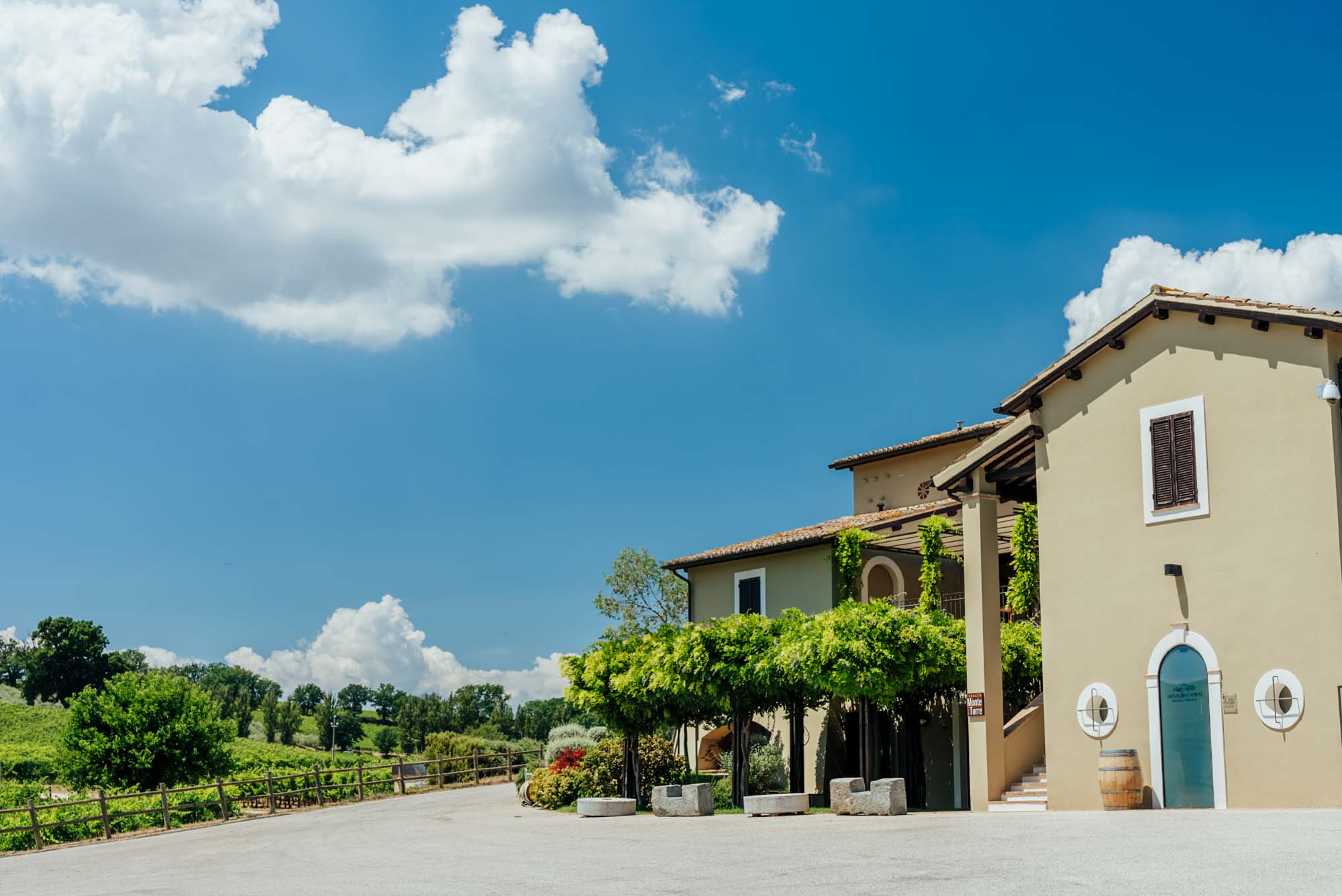
In the 19th century, Calindri, in his Geographical, Historical, Statistical Essay on the Papal Territorymentions Montefalco at the top "[...] of the State for its wines [...]". It was in this period that Sagrantino, which had always been devoted to low productivity, began to receive important recognition.
In 1875 the Ampelographic Commission of Umbria was foundedset up to study the conditions of vine cultivation in the region and to suggest ways of including Umbrian wines in the large-scale trade. The ampelographic sub-commissions of Gubbio, Terni, Spoleto and Foligno are particularly active, distinguishing themselves for their reports of great value, for the technical information reported and for the interesting descriptions of the cultivation and winemaking practices typical of the areas of reference.
The ampelographic description conducted in 1879 on the Sagrantino grape is remarkable.
General knowledge of the vine and its character. Sprouting is early, vegetation robust with widespread shoots, resistant to frost and powdery mildew. It is planted in lime soil, with mixed cooking, entrusted to opiates. It is pruned to eight or nine eyes; it flowers in the first half of June; it follows the trend of the season in fruit set, so fruiting is uncertain and in favourable years abundant. It ripens in the first half of October and is used for wine.
Woody part. The shoots are rough to the touch, not very thick, hard when cut, without special colour. Nodes not very large, internodes close together, buds tomentose and protruding.
Herbaceous part. The tendrils are infrequent; the complete leaf is medium-sized, consistent, light green on the upper page, stained wine red, rough, wavy, not hairy; velvety and light green on the lower page. It has 5 regular, elongated lobes with shallow, narrow sinuses, the lateral ones open at the margin, the one at the base closed. The teeth are broad, acute, hooked. The ribs are very slightly raised, not reddish in the centre. The petiole is a little shorter than the midrib.
From 13 to 20 September 1925, a regional wine and oil exhibition is held in Montefalco. The chronicles of the time tell of a wonderful gallery in which to find the entire repertoire of Umbrian wines. On this occasion, special attention is paid to SagrantinoThe city's municipal administration instituted a prize for the best Sagrantino at the exhibition, and the jury concluded its work with the foreboding conviction that 'this production, sometimes limited to a few barrels and conducted without a rational technique, [can] achieve some commercial importance'.
Sagrantino is displayed in the of the exhibition dedicated to sweet and aromatic wines, but a dry version is also presentedas the starting point of a transformation that would pay off much later.
In 1971, the development agency of Umbria launched an experimental production of 'Sagrantino wine'. e the following year, the Cantina Cooperativa di Foligno began vinifying dry Sagrantino.
In 1973, the application for recognition of the Montefalco DOC was submitted.
In 1979, the Ministry of Agriculture and Forestry (today Ministry of Agriculture, Food and Forestry) publishes the decree recognising the Controlled Designation of Origin for Montefalco in the Rosso and Sagrantino Secco and Passito versions. In the Rosso Di Montefalco type, in addition to the obligatory Sangiovese and Sagrantino, there are varieties such as Barbera, Montepulciano and Merlot. The regulations lay down strict rules regarding the environmental conditions and cultivation of the vineyards, which give the grapes and wines their exclusive characteristics.
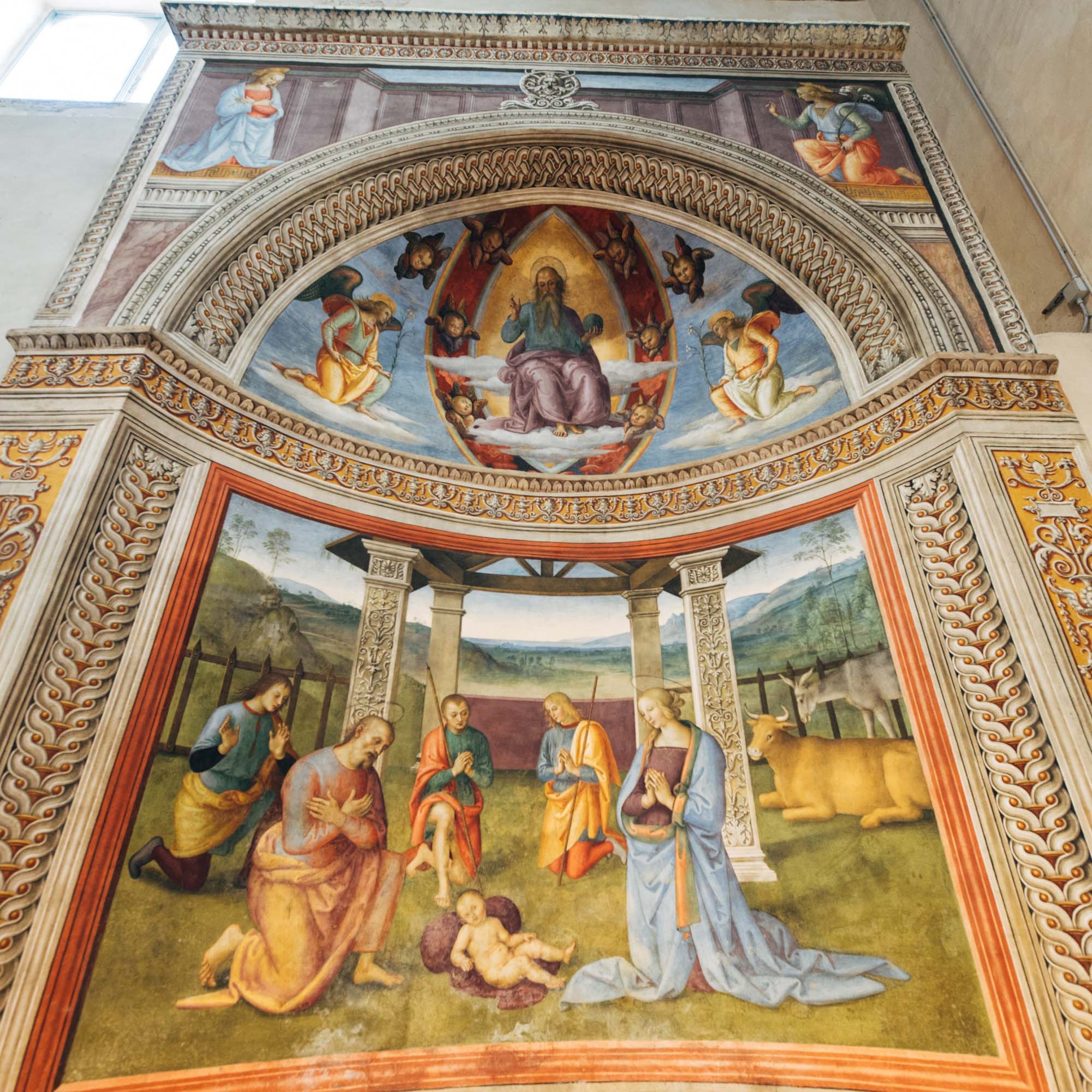
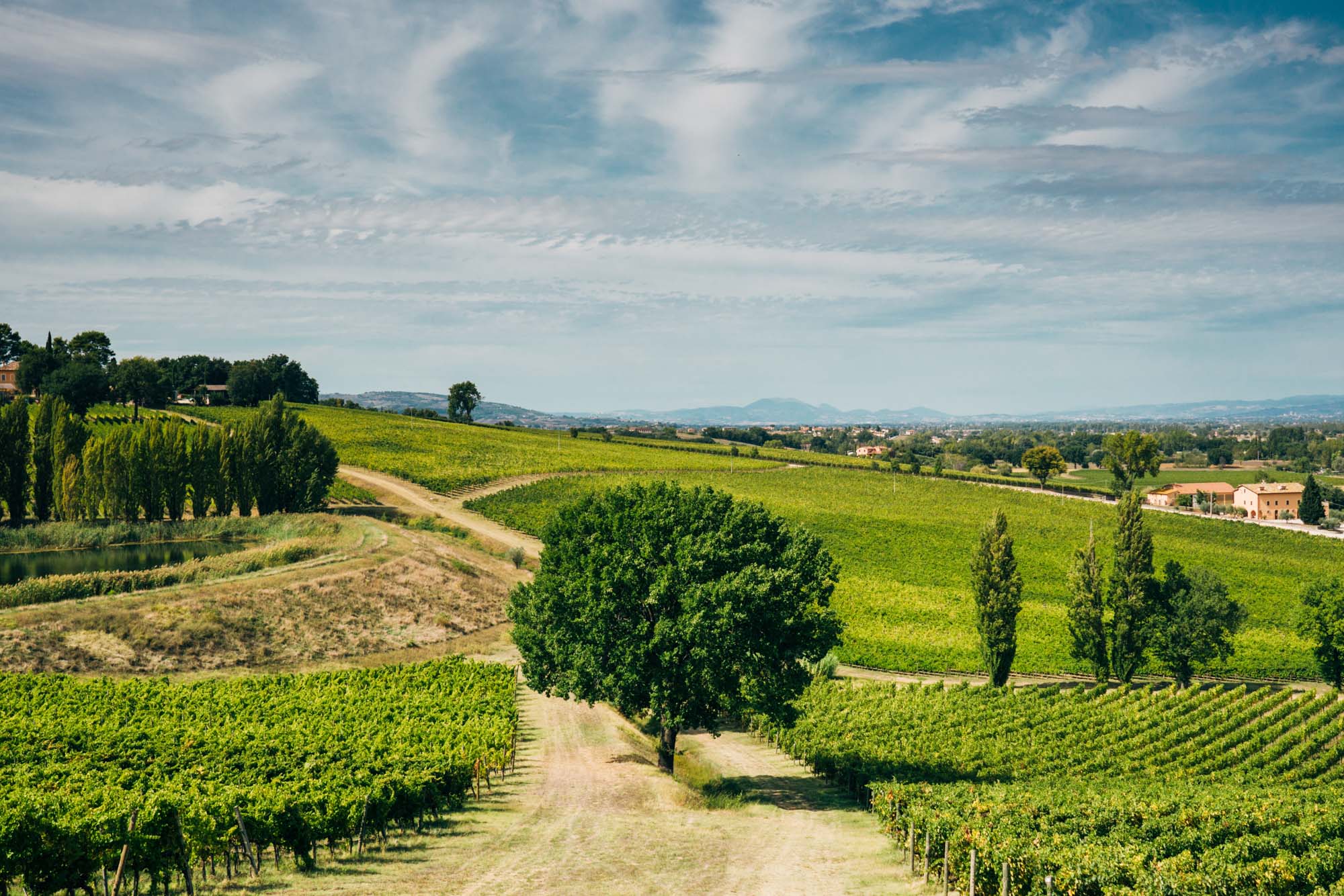
In order to valorise the production of the local Sagrantino vine, the Val di Maggio company, in collaboration with the Institute of Arboreal Cultivation of the Faculty of Agriculture of the University of Milan and the Umbria Technological Park - Sitech s. cons. a r. l., is carrying out research on two themes:
- Sagrantino clonal selection
- Application of modern agronomic techniques in the management of new plants (search for the optimal combination of density, rootstock and training form).
The clonal selection of Sagrantino
In 1992 and 1993, 'mother plants' of Sagrantino were sought in the typical production area (Montefalco, Bevagna, Gualdo Cattaneo), individuals belonging to the vine, genetically and morphologically different for one or more characteristics:
bunch size and shape; bud fertility; vegetative development of the plant; characteristics of the grapes (sugar, acid and polyphenolic content; particular aromatic characteristics); presence of manifest virosis.
The search for these mother plants was mostly carried out in old, even abandoned plants or on farms, where a few plants grown vegetatively from generation to generation were cultivated for family use. An attempt was therefore made to recover as far as possible that natural variability, which had been lost or reduced due to past mass selections. Woody material was taken from the mother plants identified and grafted in the nursery onto two different rootstocks in order to obtain rooted cuttings (thus from each mother plant the presumed clones were obtained); with this material, two experimental plants were established in 1994 in different soil and climate zones in the Sagrantino growing area.
The various presumed clones are now subjected to scientific investigation to describe the vegetative-productive characteristics: bud fertility, average weight of production, bunch size and morphology; sugar content, pH, total acidity, malic acid and tartaric acid content of the musts; polyphenol and anthocyanin content of the skins; possible presence of virosis through the 'Elisa' test. The grapes of the individual presumed clones are also subjected to microvinification at the Istituto Agrario di San Michele all'Adige (TN) in order to assess the characteristics of the wines obtained, both through analytical methods and through tastings by a group of selected and trained persons (tasting panel). By repeating the scientific investigation procedures over the years, it is possible to identify that group of clones that are interesting for improving the quality of Sagrantino, clones that will be homologated according to current legislation.
This selected and certified clonal material will be used for future plantings of polyclonal fields with a broad genetic base, choosing the optimal combination of clones in the different Sagrantino growing areas and for the different oenological purposes to be achieved.
Agronomic Techniques
In two different plantings carried out in 1994, the vegetative-productive and qualitative characteristics of Sagrantino grown with different agronomic solutions are compared:
we compare the characteristics of plants trained using the Palmetta training system (typical of the area with a density of 1700 plants per hectare) with innovative forms of training such as Guyot and spurred cordon at different planting densities (3200, 3800, 4800 and 5700 plants/ha). Each combination of training form and density is repeated on seven rootstocks (3309 C, 161-49 C, 1103 P, 110 R, 140 Ru), which differ in terms of vigour and resistance to different problems (limestone, drought, ...); in total, about 40 theses are compared for each experimental field. The production of the individual plants is corrected by manual thinning in order to obtain yields of 8 t/ha as per DOCG specifications. For each thesis, vegetative-productive measurements are carried out as already described for clonal selection (except for DNA mapping and the Elisa test); microvinifications of the harvested grapes are also carried out for these theses. It must be borne in mind that the search for the best obtainable combination of planting density, training form and rootstock must not disregard the possibility of an advantageous mechanisation of cultivation operations, without prejudice to obtaining the best possible quality. As with clonal selection, it is necessary to have the results of several years of comparison, in order to take into consideration the influence of the year on the vegetative-productive characteristics of the various combinations. The results of clonal selection will result in the identification and description of Sagrantino clones, suitable for the different environments of the growing area and for the different oenological purposes; these clones will be homologated and entered in the National Clone Register according to the regulations dictated by legislation.
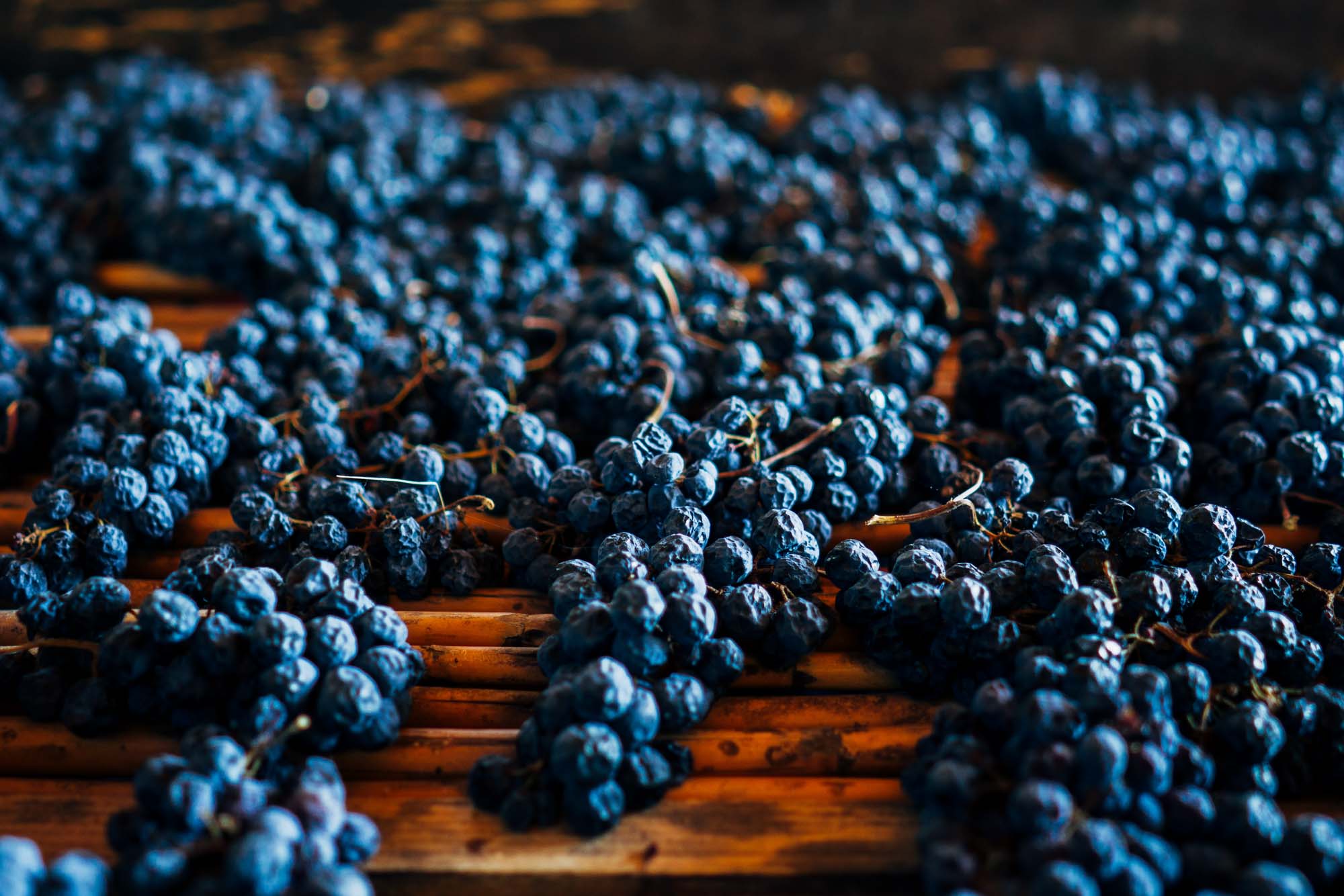
The history of the Caprai winery began in 1971 when Arnaldo Caprai, a successful textile entrepreneur, bought forty-five hectares in Montefalco with the intention of following up his business story. In 1988, the company management passed into the hands of his son Marco who, with great passion, launched a project to promote Sagrantino, an indigenous Montefalco vine with enormous qualitative potential.
The ongoing quest for production excellence and the constant commitment to process innovation are the keys to the international success of Sagrantino di Montefalco and the Arnaldo Caprai winery. Innovation and applied experimentation guide the company towards a dynamic and modern agriculture, based on a profound agronomic knowledge of the land and the use of innovative management technologies. Improving environmental, economic and social sustainability becomes the constant commitment of the company, which since 2008 has been the leader of the territorial sustainability project Montefalco 2015: the New Green Revolution.
After more than 10 years of researchcarried out by a team of ten agronomists, we succeeded in obtaining a grape variety that, although it did not exist in nature, was latent in the genetic characters of Sagrantino rosso. The result was obtained by self-fertilisation, one of the most common and longest-used methods for the genetic improvement of vines to establish new varieties, which makes it possible to obtain pure lines of the same vine. Although it includes human intervention, it has nothing to do with molecular genetics and gene transfer. Unlike genetic improvement by the vegetative route, which exploits the heterogeneity of characters that occur as a result of natural or induced budding mutations (as in the case, for example, of white, grey and black Pinot), genetic improvement by the sexual route is based on the disjunction of characters that reveals all the genetic potential of the same individual.
In the old Sagrantino vineyards, we chose, isolated and self-fertilised different plants. From the bunches obtained by self-fertilisation, we obtained seeds, which we planted in an experimental field, turning them into seedlings. After an initial selection from the resulting population, we chose around 250 genotypes that were subsequently propagated by vegetative propagation, including grey Sagrantino, naturally red and white.
This work has, therefore, allowed us to uncover all the genetic traits of Sagrantino, both dominant and recessive, including white berries. Initially, upon discovering the white berries, we thought we had not sufficiently isolated the self-fertilised plants from contact with other pollens. On the contrary, DNA tests confirmed that it was indeed Sagrantino: a white Sagrantino from a phenotypic point of view, but red from a genotypic point of view. This would suggest that there was also a white Sagrantino in the Sagrantino genealogy that, with this non-dominant character in its evolution, is as if it had been abandoned. This experiment is part of the long work that we have been doing for years to unravel all the qualities of Sagrantino, from its genetic variability to all the possible characteristics inherent in the variety, both to select the best clones and to discover the genetic origin of this vine.
This work will also have cultural implications. The data collected will make it possible, through DNA analysis and comparative genetics, to reconstruct the existence or non-existence of kinship links between Sagrantino and other grape varieties.
From a production point of view The first harvest of white Sagrantino grapes took place in 2006 in the experimental vineyards covering 10 hectares. The grapes submitted for analysis will allow us to establish whether they possess the characteristics to be vinified definitively and produce a new wine, Sagrantino di Montefalco Bianco.
